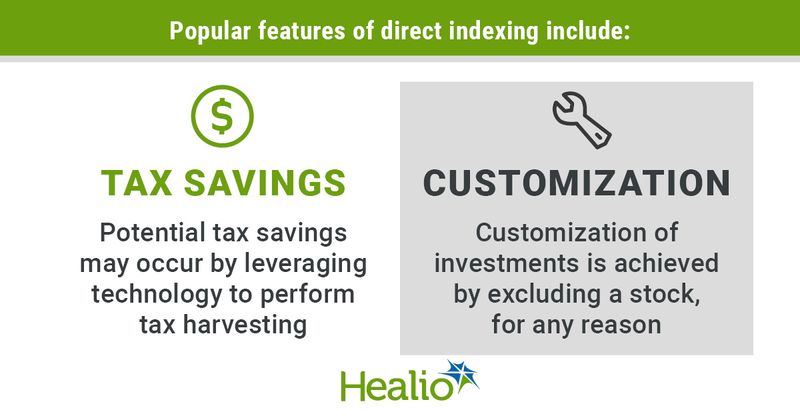Direct indexing: A new investment strategy in the marketplace
If you are a physician who follows the financial media, amid the stories of gloom and doom, you have likely heard of a new investment strategy being offered by many financial institutions called direct indexing.
The challenge associated with any new investment product, like this one, is determining if the instrument is suitable for you. The objective of this article is to help you understand direct indexing, answer the most frequent questions about it and guide you in assessing whether the approach warrants further consideration for your circumstances.

What is direct indexing?
Direct indexing is an investment strategy that combines characteristics of exchange traded funds (ETFs) and separately managed accounts.

An ETF is a passive investment strategy, attempting to track a segment of the market. The segment could be an index, such as the Standard & Poor’s (S&P) 500 index, Russell 1000 index or the Bloomberg aggregate bond index. ETFs could also attempt to mimic the results of a sector, industry, geographic region, country or socially responsible index.


Separately managed accounts are investment strategies operating in many of the same market segments as the ETFs previously listed, however, the objective of those strategies is to outperform the respective index. Investors allocating to a separately managed account own the underlying securities within the designated market segment. A large-cap growth strategy will own individual technology stocks and a municipal bond strategy will own individual bonds of cities, states or counties. The investor is paying for active management; therefore, the expenses are typically significantly higher for a separately managed account compared with an ETF.
An ETF investor will own a single security (however, they will indirectly own the companies comprising the index). A separately managed account could directly own hundreds of securities.
Direct indexing is a passive strategy that attempts to track a segment of the market, rather than outperform its respective benchmark. The direct indexing approach will own individual securities, as opposed to offering the bundled approach of an ETF.
Why would an investor sign up for market matching performance with a slightly higher cost (relative to an ETF)?
Benefits of direct indexing
While direct indexing has two key features that have captured the attention of advisors and investors, the potential tax savings is easily its most popular feature. Direct indexing leverages technology to perform tax harvesting, realizing losses to offset gains. Investors in the top tax bracket, like many physicians are, may find this feature valuable. Even in a year when a broad index offers double-digit returns, a direct indexing investor is typically presented with the opportunity to realize losses. In 2021, the S&P 500 was up more than 27%. However, more than 70 stocks within the index finished the calendar year lower. If an investor experiences a year in which they have gains from other investments, realizing losses in a direct indexing strategy could save thousands in taxes. An ETF would not provide the same opportunity in the prior scenario.
Customization is also a popular feature of direct indexing. Consider a physician who does consulting work for a large, publicly traded medical device company. If the physician received stock compensation for their services, and the company was successful, significant wealth may have been accumulated in the stock. The surgeon can elect to exclude the medical device company from their directing indexing investment. A stock can typically be excluded for any reason, including environmental, social and corporate governance (also referred to as ESG). In fact, many companies offering direct indexing have ESG-focused strategies available to investors.
Best candidates for this product
Optimal candidates for direct indexing are investors who have accumulated significant assets in non-retirement accounts. Direct indexing is ideally used as a component of a larger investment strategy. While an investor can find firms that offer solutions with lower minimums, we think an investor should have at least $100,000 in a non-retirement account to truly benefit from the strategy. An account holder is likely to own between 250 and 600 individual securities upon implementation. Therefore, position size can be exceedingly small. Realizing dozens of $8 to $10 losses is not necessarily practical.
The higher a physician’stax bracket, the greater the benefit of tax-loss harvesting. One can offset 100% of capital gains by realizing capital losses and can offset up to $3,000 in income, according to current tax law. Effective tax management can improve one’s net return. Research has attempted to quantify the value provided by active tax harvesting. A study by Terry Burnham, a finance professor at Chapman University, evaluated a tax-loss harvesting strategy owning the 500 largest U.S. stocks by market cap from 1926 to 2018. The study results suggested the tax-managed approach would have added returns of 0.82% annually greater than an approach in which the companies’ stocks were passively owned. Tax rates of 15% were used for long-term capital gains and 35% for short-term capital gains.
Today’s top rates are higher than those assumed in the study (long-term capital gains rates max out at 20% and may be subject to a 3.8% investment income surtax). An argument could be made that 0.82% of added value annually could approach 1% if today’s rates were applied to Burnham’s research. Vanguard performed a similar study, with like findings.
Investors interested in customizing their index could also be candidates for direct indexing. The ability to exclude securities may provide value to individuals with unique circumstances or preferences.
Drawbacks
When comparing ETFs to direct indexing, the latter will be more expensive. Index ETFs have operating expenses ranging from 2 to 20 basis points (on average). As of the writing of this article, direct indexing strategies were charging 25 to 40 basis points (0.25% to 0.40%) for their service. An ETF will be the better choice for most investors in a tax advantaged account, simply due to cost.
Individuals who use direct indexing are also adding complexity. Not only is one buying 300 to 600 securities, but one will also need to be prepared for an overwhelming number of trade confirmations and shareholder documents. Tax returns may become more complicated, and an investor could be required to coordinate the tax-loss harvesting of the direct investing account with their other investments. Leveraging an advisor to help with this process and selecting a custodian who will aggregate communication is critical.
Investors who are customizing their index may experience tracking error — the divergence between the price behavior of this strategy vs. its benchmark index. Returns will drift from the benchmark index if securities are excluded or if tax harvesting is performed frequently. The difference in returns vs. the target index may be small, however, divergence is a potential drawback.
If you are self-directing investments, another consideration is how you will oversee a mature direct indexing portfolio. A time will come (likely several years in the future) when all losses have been realized and the portfolio consists exclusively of gains. You will eventually own an expensive index fund and will need to ask yourself if you are interested in managing a portfolio of several hundred stocks.
Conclusion
Making the decision to use direct indexing is no different than the process to evaluate other investments. An investor’s tax bracket, net worth, risk tolerance, composition of assets, interest in customization and desire for simplicity are all factors in determining whether the approach is appropriate. Potential tax benefits are typically the driving factor behind implementing a direct indexing strategy.
Realizing gains from existing investments may not be an advisable method of funding a direct indexing strategy. Investors with cash available to invest in a non-retirement account or individuals who have realized losses and are looking to reallocate capital are typically candidates for direct indexing.
Direct indexing is not appropriate for every investor. Work with a professional advisor prior to implementing this strategy or to obtain additional information.
References:
Chaudhuri SE, et al. Financial Analysts Journal. 2020;doi.org/10.1080/0015198X.2020.1760064.
personalized_indexing_a_portfolio_construction_plan.pdf. Published March 2020. Accessed July 22, 2022.
Wealth Planning for the Modern Physician and Wealth Management Made Simple are available free in print or by ebook download by texting HEALIO to 844-418-1212 or at www.ojmbookstore.com. Enter code HEALIO at checkout.
For more information:
Sanjeev Bhatia, MD, is an orthopedic sports medicine surgeon practicing at Northwestern Medicine in Warrenville, Illinois. He can be reached at sanjeevbhatia1@gmail.com or @DrBhatiaOrtho. David B. Mandell, JD, MBA, is an attorney and founder of the wealth management firm OJM Group www.ojmgroup.com, where Andrew Taylor is a partner and wealth advisor. You should seek professional tax and legal advice before implementing any strategy discussed herein. They can be reached at mandell@ojmgroup.com or 877-656-4362.

